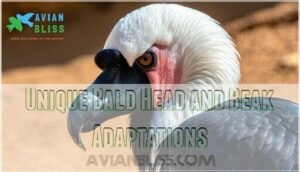This site is supported by our readers. We may earn a commission, at no cost to you, if you purchase through links.
 You’ll be amazed by facts about the Andean condor – this 33-pound giant boasts a massive 10.5-foot wingspan that makes it one of the world’s heaviest flying birds. You can spot them soaring at 16,000 feet through South America’s mountains, from Colombia to Tierra del Fuego.
You’ll be amazed by facts about the Andean condor – this 33-pound giant boasts a massive 10.5-foot wingspan that makes it one of the world’s heaviest flying birds. You can spot them soaring at 16,000 feet through South America’s mountains, from Colombia to Tierra del Fuego.
These scavengers serve as nature’s cleanup crew, feeding on carrion to prevent disease spread. They’re monogamous partners who lay just one egg every two years, requiring 18 months of parental care.
With fewer than 6,700 individuals remaining, these impressive birds face serious conservation challenges from habitat loss and human persecution. Their survival secrets reveal surprising adaptations.
Table Of Contents
- Key Takeaways
- Fascinating Physical Features of The Andean Condor
- Andean Condor Habitat and Range
- Diet and Ecological Role of The Condor
- Andean Condor Breeding and Life Cycle
- Conservation Status and Threats to Survival
- Frequently Asked Questions (FAQs)
- What are three facts about the condor?
- How far can Andean Condors fly?
- How long do Andean Condors live?
- What is unique about the Andean condor?
- How do Andean Condors adapt to high altitude environments?
- Can Andean Condors be found in urban areas or cities?
- How do Andean Condors interact with other bird species?
- What is the average lifespan of an Andean Condor?
- Are Andean Condors considered sacred animals in any culture?
- How long do Andean condors live?
- Conclusion
Key Takeaways
- You’ll be amazed by the Andean condor’s massive 10.5-foot wingspan and 33-pound weight, making it one of the world’s heaviest flying birds, capable of soaring at altitudes up to 16,000 feet through South America’s mountains.
- You can’t overlook their crucial role as nature’s cleanup crew—these scavengers feed on carrion to prevent disease spread and maintain ecosystem health across the Andes.
- You’ll discover they’re devoted parents who form lifelong partnerships, laying just one egg every two years and providing 18 months of parental care to ensure their chick’s survival.
- You need to know that fewer than 6,700 Andean condors remain in the wild due to habitat loss, poisoning, and human persecution, making conservation efforts critical for their survival.
Fascinating Physical Features of The Andean Condor
You’ll notice the Andean condor’s massive 10.5-foot wingspan and 33-pound body frame make it one of the world’s heaviest flying birds.
The condor’s distinctive white collar, bald head, and sex-specific eye colors create unique identification markers that researchers use for field observations.
Impressive Size and Wingspan
You’ll be amazed by the Andean Condor’s massive proportions. These stunning birds showcase jaw-dropping Body Proportions, with males reaching 33 pounds and boasting a wingspan stretching 10.5 feet. Their Streamlined Feathers and specialized Wing Structure enable smooth gliding through mountain air currents, while strategic Weight Distribution optimizes their Flight Patterns across South America’s rugged terrain.
- Wingspan reaches 10.5 feet – twice an average woman’s height
- Body weight up to 33 pounds makes them heavyweight champions
- Flight Patterns rely on thermal currents for energy-efficient soaring
- Wing Structure perfectly adapted for mountain wind conditions
- Weight Distribution allows graceful gliding with minimal energy expenditure
Distinctive Feather Patterns and Colors
Beyond their impressive size, you’ll notice Andean condors display striking feather coloration patterns. Males sport distinctive white wing markings and a prominent white collar around their necks, while females lack these markings. Their flight feathers appear jet-black with contrasting white patches that create dramatic visual displays during soaring.
The plumage texture remains remarkably uniform across Vultur gryphus populations throughout their range.
Unique Bald Head and Beak Adaptations
Unlike many feathered raptors, you’ll notice the Andean Condor’s completely bald head fulfills multiple practical purposes. This distinctive head plumage absence represents vital hygiene adaptations that prevent bacterial buildup when feeding on carrion. The powerful, hooked beak shape of Vultur gryphus efficiently tears through tough hide and bone.
- Sanitary feeding advantage – Bald Head Benefits include easy cleaning after messy meals
- Heat regulation – Exposed skin helps manage body temperature during soaring
- Enhanced vision – Unobstructed head movement improves scanning for carcasses
- Reduced parasites – Fewer hiding spots for mites and other external parasites
These feeding habits adaptations make Cathartidae family members exceptionally efficient scavengers in harsh mountain environments.
Eye Color Differences Between Sexes
When observing Andean condors in their natural habitat, you’ll notice a striking difference in their eye colors between sexes. Males display rich brown eyes, while females showcase vibrant red irises. This sexual dimorphism acts as a reliable field identification marker for researchers studying condor populations and mating behaviors.
This eye color genetics helps scientists track breeding pairs and monitor condor conservation efforts effectively.
Andean Condor Habitat and Range
You’ll find Andean condors across South America’s diverse landscapes, from Colombia’s peaks to Tierra del Fuego’s windswept shores.
These massive birds inhabit high mountain ranges, coastal cliffs, open grasslands, and desert regions where strong air currents help them soar effortlessly with their 10-foot wingspans.
High Peaks of The Andes Mountains
You’ll find the Andean Condor soaring above Mountain Ecosystems at astonishing heights, including peaks reaching up to 16,000 feet. These Peak Habitats within Andean Geography provide perfect thermal currents for smooth gliding.
The Andean Condor prefers high mountains, including peaks of at least 5000 meters, where Alpine Climbing enthusiasts might also spot this stunning bird traversing the rugged Andean Mountain terrain with great precision. The Andean Condor’s habitat is characterized by strong air current systems, which enable them to fly efficiently.
Open Grasslands and Alpine Regions
You’ll find Andean Condors sweeping across open grasslands and alpine regions where wind patterns create perfect thermal updrafts. These mountain ecosystems provide ideal terrain features for their soaring flight style.
Grassland ecology aids the condor habitat conservation efforts throughout Andean Mountain ranges. Alpine habitats offer abundant thermals that make smooth gliding possible across vast territories.
Coastal Areas and Lowland Deserts
You’ll discover Andean condors thriving in unexpected coastal migration routes and desert adaptation zones far from their mountain strongholds. These majestic birds exploit wind patterns along sea level territories, traversing coastal erosion zones with great precision.
Andean Condor Habitat extends beyond peaks into Chile’s Atacama Desert, where condor habitat conservation efforts protect critical feeding corridors. Andean condors demonstrate impressive desert adaptation, soaring effortlessly through arid lowlands while maintaining their essential ecological role.
Nesting Preferences and Territory
Andean condors select cliff dwellings at extreme elevations, often exceeding 5,000 meters above sea level for their nesting sites. These territorial marking specialists choose inaccessible rocky outcrops and caves that offer protection from predators and harsh weather conditions.
- Nesting behavior involves minimal construction – condors create shallow depressions on bare rock surfaces
- Breeding grounds are strategically located within 200 kilometers of reliable food sources
- Cliff dwellings provide multi-generational use, with some nests active for several consecutive years
- Territorial marking occurs through white droppings on nearby perches while keeping nest entrances clean
- Andean condor habitat selection prioritizes central locations within their vast territories for vital access
Andean condors are known to thrive in areas with abundant scavenger food sources, which is essential for their survival.
Diet and Ecological Role of The Condor
You’ll discover that Andean condors function as nature’s cleanup crew, feeding primarily on carrion from large mammals like deer, cattle, and sheep.
Their scavenging behavior removes harmful bacteria and disease-causing organisms from dead animals, making them essential for maintaining ecosystem health across South America’s mountains and grasslands.
Primary Scavenger and Carrion Feeder
You’ll witness nature’s leading cleanup crew in action. Andean Condors function as carrion eaters, performing their scavenging role by locating deceased animals through sharp eyesight. These New World Vultures consume large carcasses like cattle and deer, maintaining ecosystem balance by accelerating the decay process and removing harmful bacteria from decomposing flesh.
| Food Sources | Preferred Size |
|---|---|
| Cattle carcasses | Large mammals |
| Deer remains | Medium-sized prey |
| Sheep carrion | Domestic livestock |
Hunting Small Mammals and Birds
While carrion remains their main food source, you’ll occasionally spot Andean condors hunting live prey. Their hunting techniques include swooping down on small mammals and weak birds. These impressive raptors use strategic Prey Selection and opportunistic Foraging Strategies:
- Target newborn llamas, sheep, and goats in remote areas
- Catch small rodents and ground-dwelling birds when available
- Focus on injured or sick animals that can’t escape
- Coordinate group hunting during breeding season for extra nutrition
Importance in Ecosystem Cleanup and Disease Control
Scavenging transforms these massive birds into nature’s best cleanup crew. As carrion eaters, Andean condors play an important role in preventing disease spread by consuming carcasses. Their ecological job maintains ecosystem balance through efficient carrion management. These top scavengers greatly reduce carcass consumption time, promoting ecological health across Andean landscapes.
| Ecosystem Service | Function | Impact |
|---|---|---|
| Disease Prevention | Remove rotting carcasses | Reduces pathogen spread |
| Carrion Management | Process large animal remains | Accelerates decomposition |
| Scavenger Role | Lead scavenging communities | Controls cleanup efficiency |
| Ecological Health | Maintain nutrient cycles | Fosters soil enrichment |
| Ecosystem Balance | Remove dead biomass | Prevents contamination |
Andean Condor Breeding and Life Cycle
You’ll discover that Andean condors form lifelong partnerships and follow a remarkably slow reproductive cycle.
These giant birds lay just one chalky white egg every two years, which both parents incubate for nearly two months before the chick hatches.
Monogamous Mating Behaviors
When you observe these impressive giants in action, you’ll notice their Monogamous Relationships run deep. Andean condors mate for life, forming powerful Pair Bonding connections that last decades.
Males perform elaborate Courtship Displays with neck inflating, wing spreading, and tongue clicking to strengthen bonds. These Mating Rituals occur year-round, reinforcing their partnership beyond breeding season.
Egg Laying and Incubation Process
You’ll discover that Andean condor egg formation begins with a single chalky white egg per breeding cycle. The incubation period extends nearly two months, with both parents sharing nesting habits that involve careful temperature regulation.
During the fertilization process, parents alternate warming duties on rocky cliff ledges. This extended chick development timeline reflects the species’ slow reproductive rate, making bird species conservation and endangered species protection efforts essential for maintaining stable populations.
Chick Rearing and Parental Care
Both parents work together during Nestling Care and the Fledgling Stage, creating powerful Parental Bonding. After the incubation period ends, these Andean Condor Facts become clear:
- Chick Feeding happens through regurgitation – parents store food in their crop and bring it back to their young
- Breeding and Population success depends on extended care lasting 18 months, well past fledging at 6 months
- Bird Behavior shows no Brood Reduction – that single chick gets complete attention
You’ll witness devoted parents teaching survival skills throughout this extended period.
Conservation Status and Threats to Survival
You’ll discover that the Andean condor faces serious conservation challenges, with populations listed as vulnerable and declining across South America. Human activities like shooting, poisoning, and habitat destruction threaten these impressive birds.
Conflicts with livestock owners and capture for traditional rituals add to their survival struggles.
Endangered and Vulnerable Populations
Across South America, Andean condor populations face critical extinction risks. The IUCN Red List classifies this Vulnerable Species with fewer than 6,700 mature individuals remaining. Population Decline affects northern regions severely—Ecuador has just 94-102 wild condors, while Colombia and Venezuela teeter on the brink of local extinction.
With fewer than 6,700 Andean condors remaining worldwide, this vulnerable species faces extinction across South America’s northern regions
| Region | Population Status | Conservation Classification |
|---|---|---|
| Ecuador | 94-102 individuals | Critically Endangered |
| Colombia/Venezuela | Near extinct | Critically Endangered |
| Bolivia/Peru | 1,388/301 individuals | Vulnerable |
| Chile/Argentina | Most stable | Vulnerable |
These Endangered Birds exemplify urgent Conservation Challenges, requiring immediate Threat Analysis and targeted Condor Conservation efforts to prevent further losses.
Habitat Loss and Human-Caused Threats
Human activities directly threaten the Andean condor through habitat fragmentation and deforestation impact. Poisoning effects from contaminated carcasses and hunting persecution drive this threatened species toward extinction.
Between 2007-2021, poisoning and shooting caused 19-31% population losses. Human conflict creates barriers that prevent normal feeding behaviors, pushing these impressive birds closer to appearing on the IUCN Red List.
Ongoing Conservation Efforts in South America
Scientists and governments across South America aren’t giving up on this spectacular bird. Captive breeding and reintroduction efforts are taking flight, with multiple countries working together on habitat restoration and species protection programs.
Programs have rescued at least 370 condors and hatched 80 chicks, proving that dedicated wildlife conservation and ecosystem management can help biodiversity preservation efforts succeed across the continent.
Frequently Asked Questions (FAQs)
What are three facts about the condor?
You’ll find condors fascinating: they weigh up to 33 pounds with a wingspan reaching 5 feet, making them one of the world’s largest flying birds.
These vultures act as nature’s cleanup crew, feeding on carrion and soaring through Andean mountains.
How far can Andean Condors fly?
Like nature’s long-distance gliders, you’ll find condors covering impressive ground daily. These birds can travel distances of 200 km to 350 km per day, with some documented traveling up to 150 miles a day in search of food.
How long do Andean Condors live?
You’ll witness these impressive birds living impressively long lives—reaching 50 years in the wild and potentially 80 years in captivity. Their longevity rivals humans, making them nature’s endurance champions.
What is unique about the Andean condor?
You’ll find the Andean condor’s massive 5-foot wingspan makes it one of the world’s largest flying birds.
They’re nature’s cleanup crew, soaring effortlessly on thermal currents while scanning for carrion with exceptional eyesight.
How do Andean Condors adapt to high altitude environments?
Think of them as nature’s high-altitude masters—you’ll find Andean condors using massive wingspans and efficient soaring flight to navigate thin air.
They’ve evolved specialized flight muscles optimized for gliding rather than flapping, allowing sustained flight with minimal energy expenditure at extreme elevations.
Can Andean Condors be found in urban areas or cities?
You won’t spot Andean condors in urban areas or cities. These massive birds need open landscapes, strong air currents, and wide spaces to soar effectively with their 5-foot wingspan.
How do Andean Condors interact with other bird species?
Surprisingly social for such solitary giants, you’ll find Andean condors establishing strict pecking orders when feeding. Males dominate females, and adults outrank juveniles, creating organized hierarchies that reduce conflicts at carcasses.
What is the average lifespan of an Andean Condor?
You’ll marvel at an Andean condor‘s impressive longevity. These stunning birds live up to 50 years in the wild and can reach 75-80 years in captivity, making them true mountain legends.
Are Andean Condors considered sacred animals in any culture?
In Inca cosmology, condors soared between earth and heaven as divine messengers.
Yes, you’ll find Andean condors deeply revered in indigenous Andean cultures, particularly among the Inca, who considered them sacred symbols connecting the physical and spiritual worlds.
How long do Andean condors live?
You’ll find these extraordinary birds can live up to 50 years in the wild, but in captivity they’ve reached nearly 80 years. That’s basically a human lifetime soaring through mountain skies.
Conclusion
Like Icarus soaring toward the sun, you’ve discovered how Andean condors master the skies through extraordinary adaptations. These facts about the Andean condor reveal a species perfectly engineered for high-altitude survival, from their massive wingspans to their specialized scavenging role.
You’ll find their monogamous partnerships and extended parental care fascinating, while their conservation challenges remind us that protecting these impressive birds requires immediate action. Understanding their ecological importance helps you appreciate why preserving South America’s mountain ecosystems matters for future generations.
- https://www.zoonewengland.org/franklin-park-zoo/our-animals/birds/andean-condor/
- https://lazoo.org/explore-your-zoo/our-animals/birds/andean-condor/
- https://www.chile.travel/en/blog-en-2/5-facts-you-didnt-know-about-the-andean-condor-the-most-majestic-bird-in-chile/
- https://avianreport.com/andean-condor-range-and-habitat/
- https://www.nationalgeographic.com/animals/birds/facts/andean-condor














